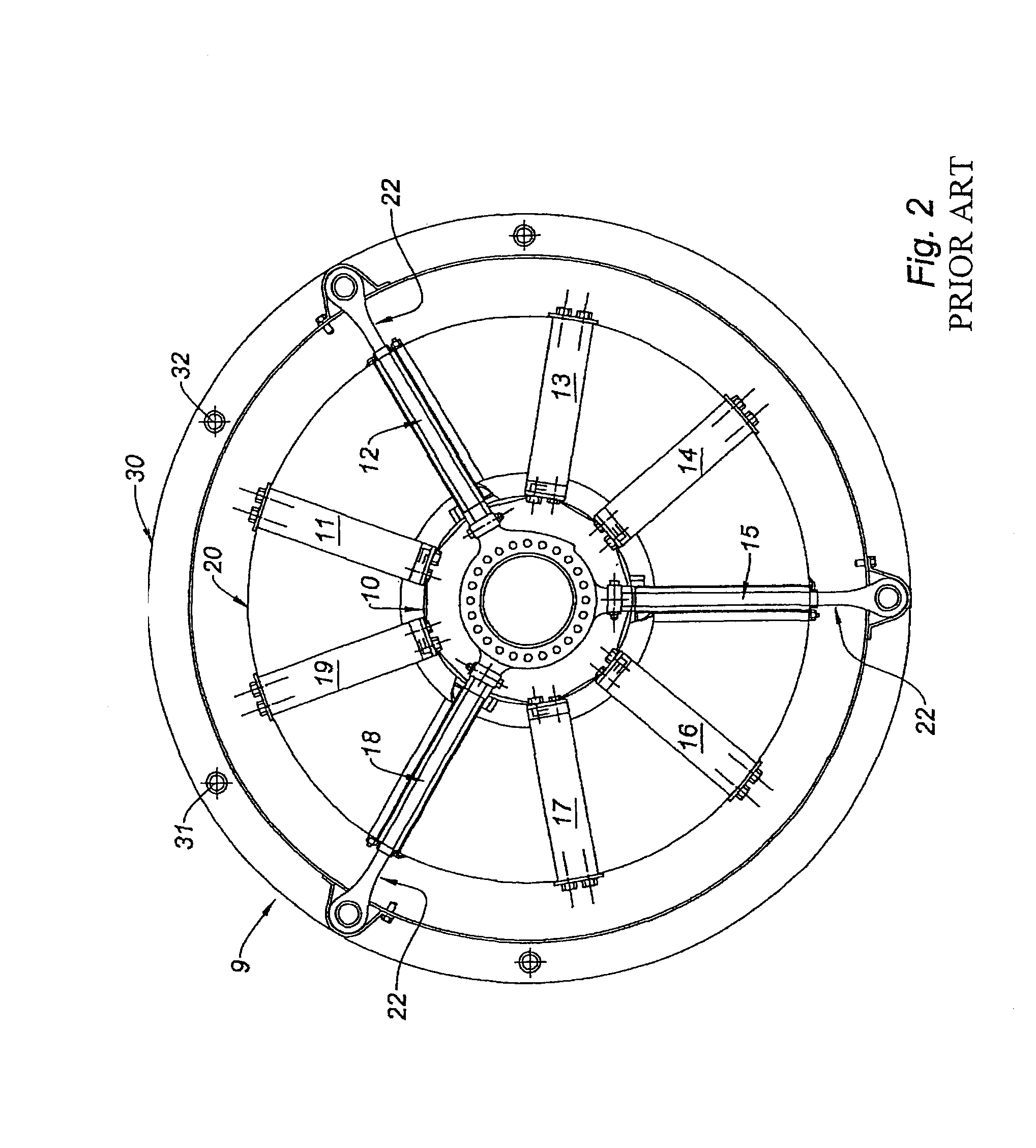Structural turbine engine casing
a technology of structural casings and turbine engines, applied in the direction of machines/engines, rocket engine plants, liquid fuel engines, etc., can solve the problems that the hollow arms of the known structural casings cannot withstand large mechanical loads, and achieve the effect of limiting the mass of the parts, increasing the life of the parts, and optimizing the shape of the casings
- Summary
- Abstract
- Description
- Claims
- Application Information
AI Technical Summary
Benefits of technology
Problems solved by technology
Method used
Image
Examples
first embodiment
[0040]In a first embodiment illustrated in FIG. 6, the body of the main arm 110 has walls of constant thickness E0 over virtually its full height H, with the exception of the base 101 and the top 102 (the fin retains a reduced wall thickness, smaller than E0).
[0041]FIG. 7 shows a transverse section through a secondary arm 100 whose walls 105, 105′ and 106 are narrowed to a reduced thickness E1. The reduction in thickness of the secondary arm walls may be around a quarter to a half of the thickness of a main arm.
[0042]Examples of the thickness of the walls of structural arms are given in table I below.
[0043]Preferably, all the walls 105, 105′ and 106 around the anterior cavity 108 of each secondary arm 100, that is to say the walls of the side faces 105-105′ and of the transverse partition 106, have such a reduced thickness E1. The walls 107-107′ of the fin at the rear of the body of the arm 100 also have a reduced thickness F, in particular one which is equal to or smaller than E1.
[...
second embodiment
[0051]Thus, in the main arm 110 represented in FIG. 9, the walls have an increased thickness S in the region 111-112 of maximum stresses, which extends here at the lower portion of the leading edge and is continued over the periphery of the base 101 and / or along the leading edge 112 of the arm 110.
[0052]In this region 111 of maximum stress, the main arm has a wall thickness S which is greater than the wall thickness E2 in the remainder of the tubular portion 105 of the arm, this increased thickness possibly amounting to twice or three times the wall thickness in the region of minimum stress.
[0053]Table I below gives examples of the thickness of the walls of the main arm according to the second embodiment of the invention.
[0054]The main arm 110 may thus have an excess thickness S in the region 111 of maximum stress, the remainder of the tubular portion of the arm having a constant thickness E2.
[0055]Advantageously, the addition of excess material S, representing around one to a few p...
third embodiment
[0058] illustrated in FIG. 10, the thickness of the walls of the main arm 110 in the region of minimum stress 115 is narrowed to a reduced value E5 which is less than the wall thickness value E3 in the region of median stress 113, the thickness E3 itself being smaller than the increased wall thickness S in the region of maximum stress 111-112.
[0059]In the region of minimum stress 115 typically covering half the surface of the walls of the arm, the wall thickness E5 may be reduced by a quarter or by half with respect to the thicknesses E3 and E4 of the walls of the arm in the regions of average stresses 113 and 114, while the region of maximum stress has a thickness S of around 100% to 200% of the thicknesses E3 and E4.
[0060]Table I below gives examples of the thickness of the main arm according to the third embodiment of the invention.
[0061]
TABLE IExamples of thicknesses of the walls of structural arms, expressed as a percentage with respect to the reference thickness E0ThicknessLea...
PUM
 Login to View More
Login to View More Abstract
Description
Claims
Application Information
 Login to View More
Login to View More - R&D
- Intellectual Property
- Life Sciences
- Materials
- Tech Scout
- Unparalleled Data Quality
- Higher Quality Content
- 60% Fewer Hallucinations
Browse by: Latest US Patents, China's latest patents, Technical Efficacy Thesaurus, Application Domain, Technology Topic, Popular Technical Reports.
© 2025 PatSnap. All rights reserved.Legal|Privacy policy|Modern Slavery Act Transparency Statement|Sitemap|About US| Contact US: help@patsnap.com



